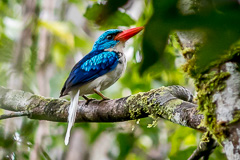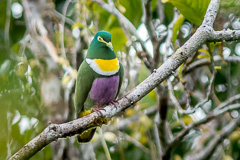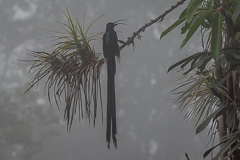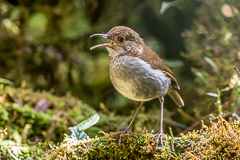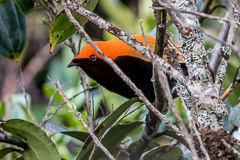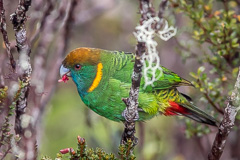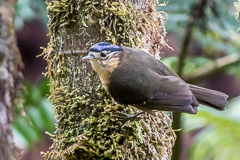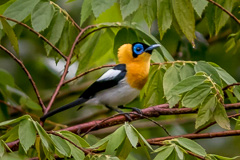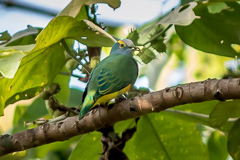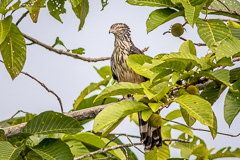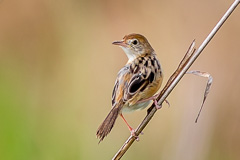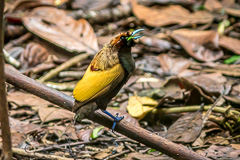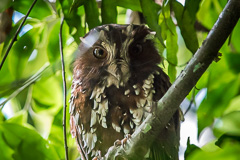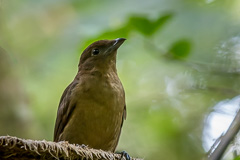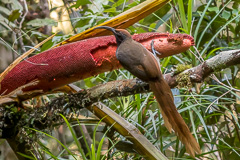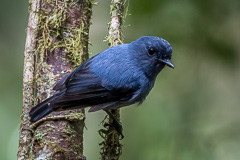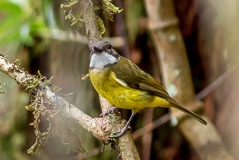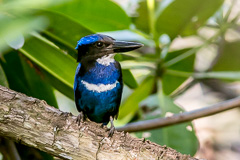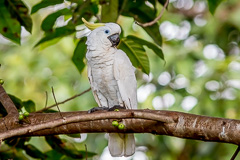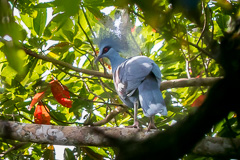Overview
Dates: |
27 Jun - 15 Jul 2019. |
With Richard Carden, Ron Johns, Sue Johns, Steve Beal, John Geeson and Sue Bryan. Birding anywhere on New Guinea is notoriously difficult, and visiting West Papua had been on the "put it off till later" list for years. However, with logistics gradually improving, no longer is it the three week camp in the rain as previously. So, having been invited to join a privately arranged trip set up by Ron and Sue Johns, it was finally time to visit. Logistical arrangements were via Bird Tour Asia, with Rob Hutchinson as guide, plus we were joined by Wilbur Goh who will guide this itinerary from next year. As usual, all worked smoothly and the trip was very successful. However, the birding remains difficult, the trails steep, slippery and muddy, the malaria risk high, and a fair degree of experience in travelling to remote areas helps decidedly. A special note to those appreciating a celebratory beer or gin and tonic in the evening, be aware that alcohol is not generally available in West Papua and is banned in several of the areas visited.
Itinerary
26 Jun. Left Chiang Mai early morning, with connection in Bangkok on Garuda to Jakarta, arriving on time at the swanky new terminal of the International Airport - an experience somewhat dulled by the use of buses still transporting passengers to the terminal building. How third world is that? Then a five hour wait in domestic, during which met up with Richard, Ron and Sue. 27 Jun. It's the near seven hour, domestic, Jakarta to Biak flight, stopping en route in Makassar, that really shows just how large an area Indonesia covers. We arrived at Biak on time and transferred to the Agung Hotel, a short distance away. Weather was hot and overcast, with rain threatening. Looking at the forecast, more of the same was to come in the following days. Having arrived a day prior to the official trip start we were able to take a few hours rest before heading out for some local birding mid afternoon. An initial wobble here, with the local agent asking US$150 for a few hours birding, quickly reduced to $70 after a challenge. Although heavy rain fell from 10:00 - 12:00, by the time we drove to the field, about 15 kilometres west of town, the worst had passed, so birding roadside scrub and forest was quite fruitful, with Geelvink Fruit Dove, Biak Gerygone, Biak Black Flycatcher, Red-capped Flowerpecker, Pale-vented Bush-hen, Great Cuckoo-Dove, Blyth's Hornbill and Biak Paradise Kingfisher. |
28 Jun. Around 10:00 we transferred to the Asana Hotel, where the rest of the group had already arrived. Although four times the price, but seemingly only half the quality, the only advantages appeared to it being nearer the airport, and having beer. At 13:50, with the remaining participants having had a few hours rest, we drove to lunch in town before heading to the field. Some thunder and rain around midday but the afternoon with only a few showers. We ended with much the same list as yesterday plus Biak Cicadabird, Brahminy Kite, Sulphur-crested Cockatoo and Geelvink Imperial Pigeon heard. After sunset at least four Biak Scops Owl, Papuan Frogmouth and Large-tailed Nightjar heard.
29 Jun. Heavy rain most of the night was continuing still at 04.30 when we left, driving to an area 30 kilometres northeast of town. Breakfast pre-dawn in the field with light rain and a heavily overcast sky which didn't look at all promising. However, the rain eased and most of the morning was dry with a great collection found - Biak Leaf Warbler, Biak Monarch, Coconut Lorikeet, Biak Scrubfowl, Biak Hooded Pitta, Emperor Fairywren and many Geelvink Pygmy Parrot. Much time was spent chasing the elusive Biak Coucal. Returned to the hotel for a late lunch, then out to continue our search for Geelvink Imperial Pigeon, without success. At dusk we returned to the same owl spot as yesterday seeing Biak Scops Owl very nicely.
30 Jun. Further overnight rain, clearing by morning, then turning into a beautiful, sunny day. A slightly late start at 04:45. We kicked off the day in more open areas hoping for Biak Coucal or Geelvink Imperial Pigeon, but in two hours not a sniff, so we returned to the main forest were we'd spent the morning yesterday, encountering an upstart local en route who objected to us driving through his village - on a public road - on a Sunday morning and making the point that as it was his village he could shoot first and ask questions later. Leaving our local Mr. Fixit to take care of this idiot we proceeded to the forest where, in several hours, eventually we had flight views of Biak Coucal as well a Biak Whistler. Back for lunch, a short siesta, then again on a mission to find our remaining target, Geelvink Imperial Pigeon, and very pleased when several eventually located.
1 Jul. With sleep depravation starting to kick in, another 04:15 start to ensure we made the 06:00 flight to Jayapura. Our connecting flight to Wamena on Wings Air was 45 minutes late, so it was not until 12:45 that we dropped our bags at the hotel. The weather, at 1,600 metres, was a beautiful 25°C and sunny. However, looking into the mountains, where we were headed, it seemed the birding was going to be wet. From Wamena to the first birding in the Snow Mountains was an hour's drive, with a couple of stops en route providing Papuan Harrier as well as the highly localised Black-breasted Mannikin. Once at higher elevation, around 3,500 metres, we all piled onto the back of one pickup and drove the rough track toward Lake Habbema. Hanging on and staying upright on the vehicle was not particularly easy, and became even more unpleasant when the inevitable rain started. Almost at the end of our drive we flushed three Snow Mountain Quail right at the side of the track - so close that several people in the vehicle failed to see them. At dusk we took up position with an overlook into the valley below and were rewarded with decent fly-by views of both Archbold's Nightjar and New Guinea Woodcock. Late arrival back at town. Usually these higher elevations are birded by camping near the top - a miserable prospect given the weather. However, due to recent tensions between local tribes, camping is not currently permitted.
2 Jul. We left the hotel at 04:45 to enable us to be at high altitude by sunrise, taking breakfast in the field. Near the pass we lucked into a couple of groups of Snow Mountain Quail, thankfully providing everyone with good views. Splendid Astrapia and Mountain Firetail were also seen nearby. The habitat destruction along the road has escalated significantly in the last few years. Though plenty of habitat remains away from the road, the terrain makes access very time consuming and difficult. Active logging still persists, with chain saws heard daily. The locals also have a particular penchant for lighting camp fires - only adding to the forest clearance. Even with a two minute stop the vehicle drivers immediately built large camp fires. Cool but sunny all morning, during which we worked our way toward the top looking for Snow Mountain Mannikin, but without luck. The remainder of the morning was spent on a steep, muddy trail running down a still well-forested valley. We had initial success in the form of great views of Greater Ground Robin, but then hours of hard work, finally finding Chestnut Forest Rail, Papuan Logrunner and partial views of Lesser Melampitta. |
Following an excellent lunch by the roadside, we returned to Lake Habbema to scan for Salvadori's Teal, with a final walk along the valley road producing Snow Mountain Mannikin, Papuan Grassbird, Painted Tiger Parrot and Black-throated Honeyeater. Rain started at 16:45, so a slow drive back to town. |
3 Jul. Started at 04.30, so as to arrive at the top by dawn, where we looked successfully for Macgregor's Honeyeater, Crested Satinbird, White-winged Robin, Mountain Robin and Alpine Pipit. During the showery afternoon we worked our way down slope making several stops, though the overcast, cool and damp conditions didn't lend themselves much to any bird activity.
4 Jul. Another early kick-off, up to around Km 22, where we followed a local logging trail through some surprisingly good forest. Although not as steep as the trails higher in the mountain, very slippery and good balance required on makeshift gully crossings. The selection from the walk included Blue-capped Ifirit, King of Saxony Bird-of-paradise, Black-breasted Boatbill and Papuan Flyrobin. Several Mountain Kingfisher gave us a total run around for hours but despite being close, were never seen. Roadside lunch at 13:00, then down to Km 20 to try for Slaty-headed Longbill - not seen, then much lower for the Stunning Ornate Melidectes and Greater Lophorina. Flushed with success, a quick dash back up the mountain produced Hooded Cuckooshrike before showers set in. Heavy rain from 21:00 through the night. |
5 Jul. We took the 08:00 Trigana flight to Jayapura. Somewhat confusingly, the airport is situated by the city of Sentani and serves both cities. On arrival, we discovered our baggage had been left behind and would appear within an hour on the next cargo plane. Hmm, heard that one before. So temporarily we transferred to the Grand Allison Hotel lounge for coffee, doughnuts and a general lounge around. Amazingly, our luggage did turn up after an hour, so we hit the road for the two hours to Nimbokrang. Very hot and humid in the lowlands - in stark contrast to our time in the Snow Mountains. Despite the 34°C heat and 100% humidity we were decked out in rubber boots and long sleeves, ready for the sticky walk to the Salvadori's Fig Parrot stakeout. Fortunately in these lowlands, trails are not steep, just lots of mud and very slippery. The parrots proved reliable and after 15 minutes of neck-breaking canopy watching we located a pair. Little seen along the way due to the heavy forest and narrow trails other than Lesser Bird-of-paradise and a fleeting Rufous-backed Fantail. A further short trek brought us to the best view point in the area but, with impeccable timing, heavy rain started at 16:00 just on our arrival. After an hour the rain had still not eased, so we gave up and returned to the accommodation somewhat bedraggled.
6 Jul. Heavy rain all night continuing still at our pre dawn breakfast. Those souls unfortunate enough to never having seen Twelve-wired Bird-of-paradise then had a wet but successful early morning search for this bird. Some of us were lucky enough to be able to join an hour or so later, when the rain had finally eased, after which we trekked to the viewpoint again. By 09:00 the rain finally stopped with us then finding Yellow-faced Myna, Coroneted Fruit Dove, Orange-bellied Fruit Dove, Boyer's Cuckooshrike and Common Spotted Cuscus. Next up, a search for King Bird-of-paradise, that took some time to actually observe as so high in the canopy. During the return walk the superb Ochre-collared Monarch found. During the afternoon we visited the canopy tower, with Pale-billed Sicklebill, Long-tailed Honey Buzzard, Coroneted Fruit Dove and Oriental Dollarbird. Late afternoon we then headed out around ten kilometres to forest edge, where in damp conditions were rewarded with a couple of Papuan Nightjar, though the hoped-for Papuan Hawk-Owl not even heard. 7 Jul. Left at 04:30 for the 20 plus kilometre drive to Jalan Korea, an old logging road running through some remaining forest, but now starting to be converted to oil palm. Evidently, little time is left before this site disappears. The overnight rain continued lightly into the morning, resulting in the overcast conditions killing off any dawn chorus, so we struggled to find much of interest. During the morning we walked around three kilometres, finding Ochre-collared Monarch, Black-sided Robin, Grey Crow, Northern Variable Pitohui, Grey-faced Cicadabird, and Black Cuckooshrike, with Purple -tailed Imperial Pigeon heard. By 11:00 the temperatures were well over 30°C and activity non-existent, so we retreated for lunch, finding Brown Oriole and Buff-faced Pygmy Parrot in the garden. A short siesta, then back out part way to where we'd spent the morning, and a couple of kilometres hike into an area of swamp forest in pursuit of Victoria Crowned Pigeon, amazingly seen well, plus a great bonus in the form of a Forest Bittern, plus a very active Blue-black Kingfisher at dusk. After dark we tried another spot for Papuan Hawk-Owl, but hearing Marbled Frogmouth only. Surprisingly, a dry night. |
8 Jul. Whilst two of the group tried, unsuccessfully for Shovel-billed Kingfisher, the remainder, given the disappointing weather yesterday, retried Jalan Korea. Despite improved weather pretty much a repeat of yesterday, though we did find another Victoria Crowned Pigeon. Other notables included White-bellied Thicket Fantail, Ivory-billed Coucal and Meyer's Friarbird. Stinking hot again by 11:00, so returned to the accommodation where a nesting Papuan Frogmouth was shown to us. Left again at 14:00 for a nearby Torrent Flyrobin stakeout, then two hours at a commanding viewpoint late afternoon - again rather quiet - before we returned to Sentani by 19:40.
9 Jul. With a few hours to spare, prior to our flight to Manokwari, we birded some remaining grassy fields near the city until about 08:00 when temperatures killed bird activity. Quite a good haul for the morning, including King Quail, Black Bittern, White-shouldered Fairywren, Tree Martin, Crimson Finch, Great-billed Mannikin, Hooded Mannikin, Golden-headed Cisticola and Chestnut-breasted Mannikin. Shortly after lunch we took the Sriwijaya flight to Manokwari, then straight into 4x4 vehicles and up into the Arfak Mountains. To say the road was pretty horrendous, would be an understatement. |
The road condition plus rain made the going pretty slow. Some late afternoon birding in the cool, damp, overcast conditions produced Mountain Honeyeater, Island Leaf Warbler, Goldenface and a disappearing Masked Bowerbird. Overnight in Minggrei village, our home for the next five nights. Facilities at this remote village have improved enormously over the last couple of years, on which the locals should justifiably be proud. There is now a newly build block house of six rooms with two bathrooms, plus a generator for power in the evenings. The villagers are very welcoming and have put much effort into finding birds, building temporary hides, and trail maintenance.
10 Jul. At around 1,700 metres, fairly cool overnight but dry. We left at 05:15 to be inside the Masked Bowerbird hide pre dawn. After three hours sat in very uncomfortable conditions, with only a single Green-backed Robin seen, we gave up, figuring the bird was not going to display this day, and priority needed to be given to the whole host of other birds to be found in these mountains.
For the return we took the longer, steeper trail back to the village, finding Spotted Jewel Babbler, Vogelkop Melidectes, Ashy Robin, Blue-grey Robin and Black Fantail. Following lunch we split into three groups, at differing hides for Magnificent Bird-of-paradise, each successful to varying degrees. Late afternoon along the road again, but little seen other than Brown-breasted Gerygone and Papuan Mountain Pigeon. 11 Jul. Another early start in order to arrive pre-dawn in hides set up for the display of Western Parotia, which only display early morning. Again, across the three hides we visited, there was differences in action, from a single bird appearing briefly to lengthy displays and matings - just the luck of the draw on any particular day. Mid morning we drove downhill to Syoubri village stopping for a Feline Owlet-nightjar the locals had discovered en route. From the village we walked an hour an a half into the hills above. Our local help again pulled roosting owlet-nightjars out of the bag, finding Mountain Owlet-nightjar and another Feline Owlet-nightjar. With excellent timing, no sooner had we arrived at the top the rain started, continuing on/off through the remainder of the day. Between showers we found Mottled Berryhunter and Rufous-sided Honeyeater, plus a know nest of Long-tailed Paradigalla. |
At 15:00 we took shelter as heavier rain started. With no respite till 16:30 we gave up and trudged back to our vehicles, arriving there just as the rain stopped. Streak-headed Mannikin on the drive out was very welcome for those who'd missed it earlier in the trip. 12 Jul. Notably windy overnight due to a cold front moving in. We again started in nearby forest on our third attempt for White-striped Forest Rail, that was again unsuccessful. We then spent several hours at a fruit feeding station that had been set up recently. This proved very useful, with visiting Black Sicklebill, Vogelkop Lophorina, Eastern Koel and Western Parotia. We then tried a couple of Vogelkop Bowerbird hides with limited success. At 13:00 we left for Penibut, deeper into the mountains. Wow, if we'd thought the road up had been bad, this was another order of magnitude worse in places. Strangely, or not so strangely in these parts of the world, several sections presumably related to a local politician, were paved and smooth as silk. Our sole quarry on this two hour drive was Grey-banded Mannikin which was thankfully found. Evening temperatures dropping and winds rising, though only small amounts of rain. |
13 Jul. Having secured permission from Dwibai village, farther downhill at 1,200 metres, to enter their land we spent the first six hours of the day in good forest, walking a distance of about 1.5 kilometres from the road. Bird of the day undoubtedly Vogelkop Owlet-nightjar, but we also found a host of other birds including Yellow-legged Flyrobin, Moluccan King Parrot, Pale-billed Scrubwren, Fairy Gerygone, Chestnut-backed Jewel Babbler, Piping Bellbird, Northern Variable Pitohui, Hooded Pitohui, Drongo Fantail and Chestnut-bellied Fantail.
Early afternoon a couple of us tried another hide session for Vogelkop Bowerbird, but found only Blue-grey Robin Vogelkop Whistler and Sclater's Whistler. For the remainder of the day we birded roadside forest around 600 metres, mainly on the hunt for Obscure Berrypecker and Wallace's Fairywren, both of which heard but unseen. |
Fruiting trees in the area held Blyth's Hornbill, Scrub Honeyeater, Pink-spotted Fruit Dove and Dwarf Fruit Dove. On return to base, realised this had been our first day without any rain.
14 Jul. Our last morning in the Arfak Mountains, so making it count we headed into the forest before light in search of Black-billed Sicklebill, a species most vocal at dawn.
As the only calling bird was at least a kilometre down the valley this required some early exercise but was eventually successful, although unfortunately not all saw the bird due to its flighty habits. And finally, on the walk out, at the eleventh hour, Vogelkop Scrubwren, which had been eluding some of us. On our return to Manokwari we did a final ten minute stop finding Obscure Berrypecker. From Manokwari we took the 40 minute Batik Air flight to Sorong - on time and the best airline we flew. Back to the lowlands, so hot and humid again. Late afternoon we visited mangroves near town, obtaining spectacular views of Blue-black Kingfisher, but less so of Black Thicket Fantail, Orange-fronted Fruit Dove and Brown-backed Honeyeater. |
15 Jul. For our final day we departed at 04:00 to Malagufuk, some lowland forest recently accessible again following land ownership disagreement between tribes. Although the drivers had reckoned on two hours for the drive, we arrived after only one hour and 20 minutes, thus enabling us to try some night birding. This proved very fortuitous, finding a single Papuan Hawk-Owl during our 40 minute foray.
Following a field breakfast we set off with the local guide walking the four kilometres through excellent forest to the village. The whole day spent in the area exploring trails around the village and scanning tree tops from the clearings. An excellent collection of species included Doria's Hawk, Western Crowned Pigeon, Pinon's Imperial Pigeon, Papuan Nightjar, Red-breasted Paradise Kingfisher, Rufous-bellied Kookaburra, Papuan Dwarf Kingfisher, Black Lory, Large Fig Parrot, Golden Cuckooshrike, Sooty Thicket Fantail, Frilled Monarch, Olive Flyrobin and Golden Myna. Left at dusk, returning to town by 20:15. 16 Jul. With no decent flight connections home, a day of rest and catching up on notes and other long outstanding communications - Internet not having been available the last five days. 17 Jul. Return flight Sorong - Jakarta - Bangkok - Chiang Mai on Garuda and Thai Airways passed without issues. Our 18 days birding in West Papua was as expected demanding and, at times, difficult. But still an enjoyable trip with many rare and spectacular birds. Many thanks to all involved in making it such a success. |
Galleries
Bird images from this, and other, birding trips.
Travel images from this, and other, birding trips.

